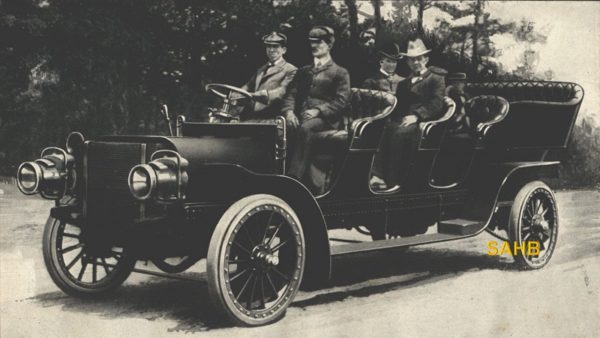
Nowadays Mack is famous for its trucks – but for 60 years from 1900 the company were proud to produce a range of buses with the same reputation for quality and durability. A 1925 book cryptically titled Bus Operating Practice included this photograph with the caption: ‘America’s first gasoline driven motor bus’.
The Mack company’s history started in 1890 when John M. “Jack” Mack took a job at the carriage and wagon firm of Fallesen & Berry in Brooklyn. In 1893 Jack and his brother Augustus bought the company. In 1894, William Mack joined the other two brothers, after running a wagon-building company in Scranton, PA. At this time, the brothers phased out carriage building and focused on wagons – and started to experiment with steam, petrol and electric vehicles.
This work paid off in 1900 when the brothers opened their first bus manufacturing plant and introduced their first successful vehicle — the 40-horsepower, 20-passenger bus shown in this Snapshot. It was built for sightseeing concessionaire Isaac Harris and operated in Brooklyn’s Prospect Park for eight years before being converted into a truck.
From 1900 to 1960 Mack produced many different types and models of buses. Over 22,000 units were built as school, transit, suburban, or intercity buses. Buses were also used as mobile post offices, sheriff’s units, or x-ray vehicles, both for hospital x-rays or track x-rays in subway systems.
Further development of petrol-powered trucks and buses was inspired by an event in the autumn of 1902, when John Mack was invited for a ride in a neighbour’s new 2-cylinder Winton automobile. The neighbour was Theodore Heilbron, captain of William Randolph Hearst’s private yacht, who lived only a block from the Mack shop on Atlantic Avenue. The Winton’s performance, significantly superior to that of the early Mack buses, prompted the brothers to develop bigger and better commercial vehicles.
In August of 1911, the brothers sold the company, and the new owners continued operation as the International Motor Company – a holding company for the Mack Brothers Motor Car Company and the Saurer Motor Company, another truck manufacturer which had a plant in Plainfield, New Jersey.
No story of a Mack, bus or truck, can be told without mention of their bulldog radiator ornament. It dates back to the First World War – admittedly many years after our Snapshot – with the Mack AC truck, introduced in 1916 and supplied to the US government with 4,500 units and the British with over 2,000. The vehicle was strong and tenacious, much like an English bulldog, and the shape of its hood (bonnet) resembled the animal too. British soldiers made the connection between dog and truck and started referring to the AC model as the Bulldog Mack. The name stuck. However, it wasn’t until 1921 that the first bulldog was featured on a Mack truck, not as an ornament but as an emblem on the vehicle’s side. The radiator ornament dates from 1932.
In later years the Mack production was exclusively of trucks and not buses – but the noble tradition of bus manufacture was not forgotten: Mack used a slogan in advertisements for many years: “The first Mack was a bus and the first bus was a Mack.”
Photo courtesy of The Richard Roberts Archive.







Leave a Comment